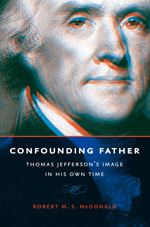WASHINGTON – The book cover of Confounding Father: Thomas Jefferson’s Image In His Own Time is not meant to be an optical illusion. Rather, the blurred image of Thomas Jefferson alludes to the duality of not only his nature, but of public opinion. Author Robert M.S. McDonald explores this polarization and analyzes the gap between Jeffersonian politics and popular sentiment. From his supporters’ vantage point, Jefferson, though a mild and meek man, was a patriot, an Enlightenment thinker whose ideas benefited all Americans.
 However, McDonald told the audience at a March 23rd lecture here at the library of the Daughters of the American Revolution, others viewed Jefferson in much darker terms, seeing him as a threat to nascent democracy.
However, McDonald told the audience at a March 23rd lecture here at the library of the Daughters of the American Revolution, others viewed Jefferson in much darker terms, seeing him as a threat to nascent democracy.
“Some people viewed him as the anti-Christ,” said McDonald, a Professor of History at the United States Military Academy, said of Jefferson. His detractors saw him as menacing; an atheist aiming to unleash the chaos of the French Revolution in America. In 1800, Timothy Dwight, the president of Yale, stated that if Jefferson were elected president “the Bible will be cast into a bonfire, and our children either wheedled or terrified into singing heretical hymns, and all of our wives and daughters will be made the victims of legal prostitution.” Those extreme fears were fanned by Jefferson’s severe criticisms of both Vice President John Adams and President George Washington, opinions revealed after letters he wrote were leaked and published. His words were interpreted as un-American, as prior to the election of 1800 there was little public understanding that Jefferson was the main author of the Declaration of Independence.
Though as the product of Virginia agrarian wealth he inhabited a world of privilege, Jefferson was acutely aware of his public image. His broadly popular standing evolved over time, in part due to his own tireless efforts. Throughout his time in public office, Jefferson kept a scrapbook of newspaper clippings that ranged from scorn to praise in order to, as McDonald put it, keep a “thumb on the pulse of public opinion.
McDonald, a self-declared fan of the third U.S. president– he met his wife at Monticello and named his son Jefferson– attempts in his book to breach the gap between perception and politics to weave a narrative of conflicting ideologies that shaped the newly founded United States of America. What evolved in the years of the Early Republic was the battle between Alexander Hamilton’s Federalists and Jefferson’s Republicans. These Founding Fathers clashed on the direction in which to take the young nation, with Jefferson regarding the U.S. Constitution as an explicit contract that delegated certain specified powers to the federal and local and state governments. Hamilton had a much more expansive view of the Constitution, believing in all sorts of actions not directly specified within it. These clashes and divergent views, famously seen in the fight over the creation of a national bank, eventually led to the two-party system within the United States and left an enduring framework of bipartisanship.
 However, McDonald told the audience at a March 23rd lecture here at the library of the Daughters of the American Revolution, others viewed Jefferson in much darker terms, seeing him as a threat to nascent democracy.
However, McDonald told the audience at a March 23rd lecture here at the library of the Daughters of the American Revolution, others viewed Jefferson in much darker terms, seeing him as a threat to nascent democracy.




